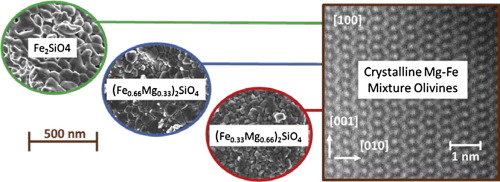Journal of Colloid and Interface Science ( IF 9.4 ) Pub Date : 2018-01-10 , DOI: 10.1016/j.jcis.2018.01.036 Odeta Qafoku , Eugene S. Ilton , Mark E. Bowden , Libor Kovarik , Xin Zhang , Ravi K. Kukkadapu , Mark H. Engelhard , Christopher J. Thompson , Herbert T. Schaef , Bernard Peter McGrail , Kevin M. Rosso , John S. Loring

|
Olivines are divalent orthosilicates with important geologic, biological, and industrial significance and are typically comprised of mixtures of Mg2+ and Fe2+ ranging from forsterite (Mg2SiO4) to fayalite (Fe2SiO4). Investigating the role of Fe(II) in olivine reactivity requires the ability to synthesize olivines that are nanometer-sized, have different percentages of Mg2+ and Fe2+, and have good bulk and surface purity. This article demonstrates a new method for synthesizing nanosized fayalite and Mg-Fe mixture olivines. First, carbonaceous precursors are generated from sucrose, PVA, colloidal silica, Mg2+, and Fe3+. Second, these precursors are calcined in air to burn carbon and create mixtures of Fe(III)-oxides, forsterite, and SiO2. Finally, calcination in reducing CO-CO2 gas buffer leads to Fe(II)-rich olivines. XRD, Mössbauer, and IR analyses verify good bulk purity and composition. XPS indicates that surface iron is in its reduced Fe(II) form, and surface Si is consistent with olivine. SEM shows particle sizes predominately between 50 and 450 nm, and BET surface areas are 2.8–4.2 m2/g. STEM HAADF analysis demonstrates even distributions of Mg and Fe among the available M1 and M2 sites of the olivine crystals. These nanosized Fe(II)-rich olivines are suitable for laboratory studies with in situ probes that require mineral samples with high reactivity at short timescales.
中文翻译:

纳米级铁橄榄石和镁铁(II)混合橄榄石的合成
橄榄石是具有重要的地质,生物学和工业意义的二价原硅酸盐,通常包含镁橄榄石(Mg 2 SiO 4)到铁橄榄石(Fe 2 SiO 4)的Mg 2+和Fe 2+的混合物。研究Fe(II)在橄榄石反应性中的作用要求具有合成纳米尺寸,具有不同百分比的Mg 2+和Fe 2+以及具有良好的体积和表面纯度的橄榄石的能力。本文演示了一种合成纳米铁橄榄石和Mg-Fe混合橄榄石的新方法。首先,由蔗糖,PVA,胶体二氧化硅,Mg 2+生成碳质前体和Fe 3+。其次,将这些前体在空气中煅烧以燃烧碳并生成Fe(III)-氧化物,镁橄榄石和SiO 2的混合物。最后,在还原CO-CO 2气体缓冲液中进行煅烧可得到富含Fe(II)的橄榄石。XRD,Mössbauer和IR分析证明了良好的散装纯度和组成。XPS表明表面铁呈还原的Fe(II)形式,表面Si与橄榄石一致。SEM显示颗粒大小主要在50至450 nm之间,BET表面积为2.8–4.2 m 2 / g。STEM HAADF分析表明,橄榄石晶体中可用的M1和M2位点中Mg和Fe的分布均匀。这些富含Fe(II)的纳米级橄榄石适合进行原位实验室研究 需要在短时间内具有高反应活性的矿物样品的探针。











































 京公网安备 11010802027423号
京公网安备 11010802027423号